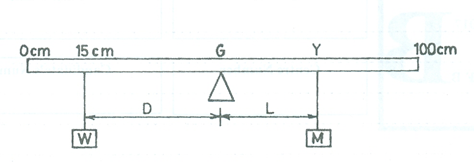Alternative B
Question 1B

- Suspend the metre rule horizontally on the knife edge. Read and record the point of balance G of the metre rule. Keep the knife edge at this point throughout the experiment.
- Using the thread provided, suspend the object labelled W at the 15cm mark of the metre rule.
- Suspend a mass M = 20g on the other side of G. adjust the position of the mass until the metre rule balances horizontally again.
- Read and record the position Y of the mass M on the metre rule.
- Determine and record the distance L between the mass and G. Also, determine and record the distance D between W and G.
- Repeat the procedure for four other values of M = 30g, 40g, 50g and 60g. In each case, ensure that W is kept constant at the 15cm mark and the knife edge at G.
- Evaluate L-1 in each case. Tabulate your readings.
- Plot a graph of M on the vertical axis against L-1 on the horizontal axis.
- Determine the slope, s, of the graph.
- Evaluate
- State two precautions taken to ensure accurate results.
You are provided with a uniform metre rule, a knife edge, masses and other necessary apparatus.
(b) (i) State the principle of moments.
(ii) Define centre of gravity.Observation
Part (a) Candidates performance was poor. Many candidates who attempted the question failed to record L-1 to the required accuracy and had difficulty in plotting graph.
Part (b) Candidates response was satisfactory.
Candidates were expected to:
- read and record G to at least 1 d.p in cm
- calculate correctly the value of D
- read five values of M in g
- read and record five positions Y of the mass to at least 1 d.p in cm and in trend
- evaluate five values of L = (Y-G)
- evaluate and record five values of L-1 to at least 3 d.p
- show composite table containing at least M, Y, L and L-1
- Both axes correctly distinguished
- plot a graph using reasonable scales
- draw line of best it
- determine the slope and intercept of the graph
- evaluate correct
- state any two of the following precautions.
e.g.
- Avoided draught
- Avoided parallax error in reading metre rule
- Repeated readings (shown on table)
- Ensured suspended masses did not touch the table
- Noted zero error on the meter rule
In part b, the expected answers are:
b(i) The principle of moments states that for a body in equilibrium, the sum of the clockwise moments about a point is equal to the sum of the anticlockwise moments about the same point.
(ii) The centre of gravity of a body is defined as the point through which its resultant
weights acts.
OR
The point where the weight of the body acts or appears to act.
OR
